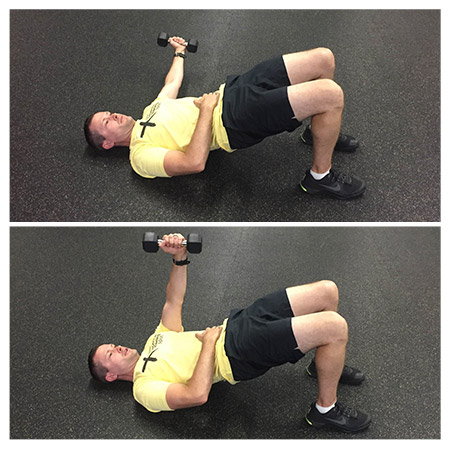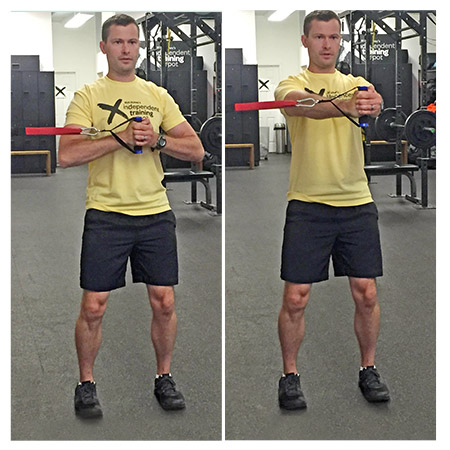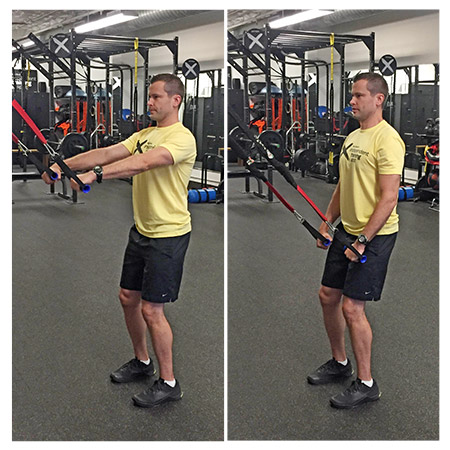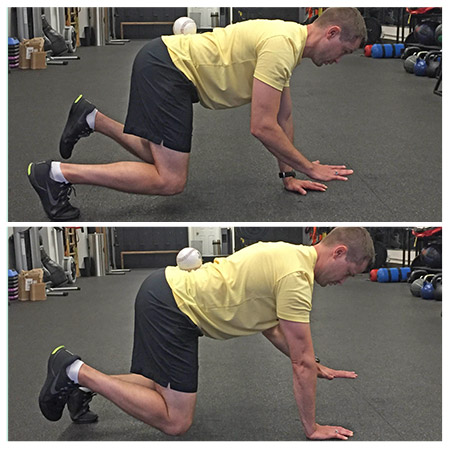The 4 Best Ab Moves for Bad Backs (No Crunches!)
Can't find a core strengthener that doesn't bother your back? These moves are ache-free, and could even help relieve your pain.

Photo: michaeljung/istockphoto
"If you have back pain, you want exercises that stabilize the spine, not move it," says Rick Richey, National Academy of Sports Medicine master instructor. That means avoiding crunching, arching the back (a mistake people often make during planks), and twisting motions. Instead, you'll tone and strengthen your midsection by contracting your abs and working against the instinct to rotate during these moves. Even better, after doing these exercises several times a week, you might notice fewer aches, since back problems can be the result of weak core muscles.
Start with this movement prep that Richey, who's also a certified personal trainer, and a corrective exercise and performance enhancement specialist, has all of his clients do before any type of core move to get a sense of how your abs should feel during the exercise. Draw your belly button in toward your spine, squeeze like you're doing a Kegel, and contract your abs like a toddler is about to jump on your stomach. Practice 10 reps, holding each for 5 seconds, then do this during each of these four exercises.
(If you feel any pain during these movements, stop and make sure you're following the form tips correctly. If the pain persists, talk to your doctor.)
Glute Bridge with Arm Fly

Weak glute muscles can contribute to back pain too, says Richey, so by working your backside in addition to your abs, this move does double duty.
1. Lie down on the floor, holding a 5-pound dumbbell in your left hand, right hand resting on your abdomen. Your legs should be a few inches apart and your knees bent at 90-degree angles.
2. Squeeze your glutes to lift your butt, lower back and mid-back off the mat, until only your feet and your upper back are touching it.
3. As you hold that bridge position, extend your left arm and bring the dumbbell straight toward the ceiling, then slowly lower it out to your left side until it's a few inches from the floor. Lift it back toward the ceiling; that's one rep. Focus on keeping your torso still and your right shoulder in contact with the mat; don't let your body rotate to the left as you bring the dumbbell toward the floor.
4. Do 15 slow, steady reps, keeping your hips up in the bridge position the whole time, then repeat with your right arm holding the dumbbell. You should be able to do 15 slow reps, and the last one or two should be a challenge—adjust your dumbbell weight if you're cruising through 15 reps or struggling to get to 10.
Pallof Press

Named after physical therapist John Pallof, this move can be done at home with a resistance band or at the gym (Richey is demonstrating on a cable machine). Here's how to do it at home.
1. Grab a resistance band and secure it in a doorframe or on a piece of furniture.
2. Stand perpendicular to the door or piece of furniture, so that your left side is facing it, grab the handle of the resistance band in both hands, and hold it in at your chest. You want to stand far enough away from the door or furniture so that the band is taught and you feel some resistance even when you're in this starting position. Make sure your back is in a neutral, natural position (no arching).
3. Keeping the rest of your body still, extend your arms straight out in front of you, feeling the resistance band get tighter as you push out. Your torso will want to twist to the left when you extend your arms—don't let it. Hold for a second when your arms are fully extended, then bring them back into your chest. That's one rep.
4. Do 15 reps, then repeat with your right side facing the door or furniture.
Lat Sweep

This is another move that can be done using a cable machine if you're at the gym (as shown by Richey). But if you're at home, it's easy to do there too. There's even a version you can do at the office.
1. Take your resistance band and secure it in a doorframe.
2. Stand far enough away from the door so that the band is tight when you grab both handles, extend your arms out and hold them slightly lower than chest height.
3. Starting in that position, keep your lower body and torso still as you keep your arms straight and sweep them down to your sides. Slowly raise them back to starting position. That's one rep; do 15. You can do a variation of this with a table too—sit down, extend your arms in front of you with palms on the table, and brace your core as you push down into the table. It's a very subtle move—you have to press down hard and really contract your abs to feel it. Hold for a second, then release, and repeat for 15 reps.
The Crawl

Richey challenges his clients by placing a yoga block on their lower back as they do this to make sure they're not swaying. Once they master that, he has them try it the way he’s demonstrating above, with a softball on their back.
1. Get into a tabletop position on all fours, then lift your knees a couple of inches off the ground.
2. Crawl forward, moving your right hand and left foot in unison, then your left hand and right foot. As you crawl, focus on not letting your body sway from side to side. Don't let your hips rise up either; they should stay level with your shoulders. Taking very small steps will help..
3. Start with 15 seconds of crawling, working your way up to 30 seconds. The goal is to be able to do three sets of 30 seconds.
Photos by Craig Thomas
Start with this movement prep that Richey, who's also a certified personal trainer, and a corrective exercise and performance enhancement specialist, has all of his clients do before any type of core move to get a sense of how your abs should feel during the exercise. Draw your belly button in toward your spine, squeeze like you're doing a Kegel, and contract your abs like a toddler is about to jump on your stomach. Practice 10 reps, holding each for 5 seconds, then do this during each of these four exercises.
(If you feel any pain during these movements, stop and make sure you're following the form tips correctly. If the pain persists, talk to your doctor.)
Glute Bridge with Arm Fly

Weak glute muscles can contribute to back pain too, says Richey, so by working your backside in addition to your abs, this move does double duty.
1. Lie down on the floor, holding a 5-pound dumbbell in your left hand, right hand resting on your abdomen. Your legs should be a few inches apart and your knees bent at 90-degree angles.
2. Squeeze your glutes to lift your butt, lower back and mid-back off the mat, until only your feet and your upper back are touching it.
3. As you hold that bridge position, extend your left arm and bring the dumbbell straight toward the ceiling, then slowly lower it out to your left side until it's a few inches from the floor. Lift it back toward the ceiling; that's one rep. Focus on keeping your torso still and your right shoulder in contact with the mat; don't let your body rotate to the left as you bring the dumbbell toward the floor.
4. Do 15 slow, steady reps, keeping your hips up in the bridge position the whole time, then repeat with your right arm holding the dumbbell. You should be able to do 15 slow reps, and the last one or two should be a challenge—adjust your dumbbell weight if you're cruising through 15 reps or struggling to get to 10.
Pallof Press

Named after physical therapist John Pallof, this move can be done at home with a resistance band or at the gym (Richey is demonstrating on a cable machine). Here's how to do it at home.
1. Grab a resistance band and secure it in a doorframe or on a piece of furniture.
2. Stand perpendicular to the door or piece of furniture, so that your left side is facing it, grab the handle of the resistance band in both hands, and hold it in at your chest. You want to stand far enough away from the door or furniture so that the band is taught and you feel some resistance even when you're in this starting position. Make sure your back is in a neutral, natural position (no arching).
3. Keeping the rest of your body still, extend your arms straight out in front of you, feeling the resistance band get tighter as you push out. Your torso will want to twist to the left when you extend your arms—don't let it. Hold for a second when your arms are fully extended, then bring them back into your chest. That's one rep.
4. Do 15 reps, then repeat with your right side facing the door or furniture.
Lat Sweep

This is another move that can be done using a cable machine if you're at the gym (as shown by Richey). But if you're at home, it's easy to do there too. There's even a version you can do at the office.
1. Take your resistance band and secure it in a doorframe.
2. Stand far enough away from the door so that the band is tight when you grab both handles, extend your arms out and hold them slightly lower than chest height.
3. Starting in that position, keep your lower body and torso still as you keep your arms straight and sweep them down to your sides. Slowly raise them back to starting position. That's one rep; do 15. You can do a variation of this with a table too—sit down, extend your arms in front of you with palms on the table, and brace your core as you push down into the table. It's a very subtle move—you have to press down hard and really contract your abs to feel it. Hold for a second, then release, and repeat for 15 reps.
The Crawl

Richey challenges his clients by placing a yoga block on their lower back as they do this to make sure they're not swaying. Once they master that, he has them try it the way he’s demonstrating above, with a softball on their back.
1. Get into a tabletop position on all fours, then lift your knees a couple of inches off the ground.
2. Crawl forward, moving your right hand and left foot in unison, then your left hand and right foot. As you crawl, focus on not letting your body sway from side to side. Don't let your hips rise up either; they should stay level with your shoulders. Taking very small steps will help..
3. Start with 15 seconds of crawling, working your way up to 30 seconds. The goal is to be able to do three sets of 30 seconds.
Photos by Craig Thomas



